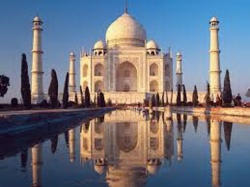Difference between revisions of "India"
(Created page with "thumb|250px| India is the cultural unit now made up of the modern states of Pakistan, India and Bangladesh. Hindus have long called India either Aryade...") |
|||
| Line 1: | Line 1: | ||
[[File:India21.jpg|thumb|250px|]] | [[File:India21.jpg|thumb|250px|]] | ||
| − | India is the cultural unit now made up of the modern states of Pakistan, India and Bangladesh. Hindus have long called India either Aryadesa or more commonly Bhārata, still its official name. Indian Buddhists always called their land Jambudīpa, the Rose Apple Land (A.I,35). The Buddha described India fairly accurately as being ‘broad in the north and narrow in the | + | India is the cultural unit now made up of the {{Wiki|modern}} states of {{Wiki|Pakistan}}, [[India]] and {{Wiki|Bangladesh}}. [[Hindus]] have long called [[India]] either Aryadesa or more commonly Bhārata, still its official [[name]]. [[Indian]] [[Buddhists]] always called their land [[Jambudīpa]], the Rose Apple Land (A.I,35). The [[Buddha]] described [[India]] fairly accurately as [[being]] ‘broad in the [[north]] and narrow in the [[south]]’ (D.II,235) and as having high mountains on its northern margin, i.e. the [[Himalayas]] (Vin.IV,197). He described India’s general environment like this: ‘Few in number are the [[pleasant]] parks, [[pleasant]] groves, [[pleasant]] stretches of land and lakes, while more numerous are the steep rugged places, unfordable [[rivers]], dense {{Wiki|forest}} thickets of scrub and thorns and inaccessible mountains.’ (A.I,35). The [[Buddha]] lived all his [[life]] in that area of {{Wiki|northern India}} then called the Middle Land,the wide flat valley of the [[Ganges]] and {{Wiki|Yamunā}} [[Rivers]]. [[Buddhism]] flourished in [[India]] for about 1000 years and then went into a long period of {{Wiki|decline}}, finally dying out in the 13th century. In the 1950’s a {{Wiki|movement}} began, mainly amongst intellectuals and untouchables led by [[Bhimrao Ambedkar]], to revive [[Buddhism]]. Since then the [[Buddhist]] population of [[India]] has grown from almost [[nothing]] to over 8 million. |
| − | Indian Buddhism, A.K. Warder, 1980 | + | Indian [[Buddhism]], A.K. Warder, 1980 |
{{R}} | {{R}} | ||
[http://www.buddhisma2z.com/content.php?id=190 www.buddhisma2z.com] | [http://www.buddhisma2z.com/content.php?id=190 www.buddhisma2z.com] | ||
[[Category:Buddhist Terms]] | [[Category:Buddhist Terms]] | ||
[[Category:India]] | [[Category:India]] | ||
Revision as of 17:59, 12 September 2013
India is the cultural unit now made up of the modern states of Pakistan, India and Bangladesh. Hindus have long called India either Aryadesa or more commonly Bhārata, still its official name. Indian Buddhists always called their land Jambudīpa, the Rose Apple Land (A.I,35). The Buddha described India fairly accurately as being ‘broad in the north and narrow in the south’ (D.II,235) and as having high mountains on its northern margin, i.e. the Himalayas (Vin.IV,197). He described India’s general environment like this: ‘Few in number are the pleasant parks, pleasant groves, pleasant stretches of land and lakes, while more numerous are the steep rugged places, unfordable rivers, dense forest thickets of scrub and thorns and inaccessible mountains.’ (A.I,35). The Buddha lived all his life in that area of northern India then called the Middle Land,the wide flat valley of the Ganges and Yamunā Rivers. Buddhism flourished in India for about 1000 years and then went into a long period of decline, finally dying out in the 13th century. In the 1950’s a movement began, mainly amongst intellectuals and untouchables led by Bhimrao Ambedkar, to revive Buddhism. Since then the Buddhist population of India has grown from almost nothing to over 8 million.
Indian Buddhism, A.K. Warder, 1980
